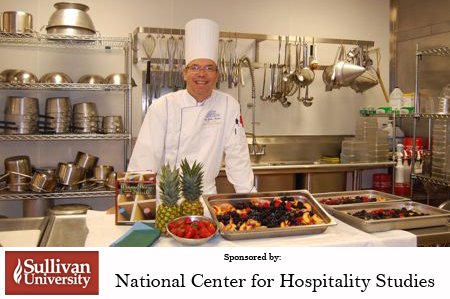Another year come and gone and with it so many words and deeds done. My tenth year at Sullivan University, the first full year for The Sage Rabbit, and many, many, ingredients, recipes and cautionary restaurant tales.
New Year’s Eve for me will be a restaurant full of people, celebrating and toasting the past year with the coming of the new. While winter may have silenced the local crops, I consider the New Year’s menu a challenge not of ingredients but perception.
While we could give you what everyone else does at New Year’s we prefer to surround you with the warmth of winter. Spicy butternut squash soup, beet and apple salad, fresh fettuccine arrabiata, roasted local chicken with winter vegetables. Warm, full of color and flavor, sustaining, that is what winter food should provide to you.
Yes, it involves more fat, richer food in general, and a familiarity with flavors needing to be built, rather than the immediate gratification of a July tomato. Your choice these days is simple; give into the 24-7 world of food where everything is at your disposal even if it’s grown a thousand miles away. Or investigate what’s grown in your neighborhood.
While it would be great to support the local economy by buying from the farmers you know, take the first brave step into seasonal eating by buying some carrots at the store, cutting them with your own hands and roasting them. Carrots have fiber, color and a sweetness that only improves with roasting. Olive oil works just as well as butter does if you want to avoid the fat, the important thing is that you’re eating something in its growing season and is nutritionally the best for you. And when you’re proclaiming those new year’s resolutions wouldn’t it be great to start with one that in many ways hits close to home?
Avoid the easy food “outs” this new year but look for the easiest methods to accomplish your goals. Pull out that old stock pot, it will come in handy for the next few months. Pick a new food or recipe once a week and buy ingredients that you’ve never tried, this is after all a new beginning.

Can you identify parsnip, celeriac, or salsify? They may seem scary to look at but they should become the basics of your wintertime diet. If you’re not willing to take that big a first step, branch out to greens and cauliflower, great sources of potassium, iron and folic acid and a break from a steady diet of broccoli.
Try lamb instead of beef, duck instead of chicken, stews and soups instead of the traditional “meat and three.” Next Sunday the 1st make sure you have your Hopping John for brunch, but try a slow roasted chicken paprikash for dinner.
Embrace the season not just for a wonderful evening on New Year’s Eve but until the green grass peeks out of the last of the snow and the warm breezes come back to the bluegrass.
There are many recipes for paprikash, it being a staunchly regional dish similar to burgoo. My recipe starts with a base of onion, garlic, herbs and butter along with a good shot of paprika or smoked paprika.
This is technically a braise where the chicken will be browned first and then cooked in stock. This is recipe that can be conveniently made in that dusty old crock pot.
Paprikash
1 whole chicken cut in half, bones can remain in.
3 large yellow onions, sliced thin
6 cloves of garlic, crushed with the side of your knife
3 full sprigs of thyme
2 sage leaves
1 bay leaf
2-3 tablespoons of Hungarian or smoked paprika
Salt and pepper to taste
Whole butter
Chicken stockTake your spilt chicken, season it with salt and pepper, and slowly brown both sides in butter. Once they are done remove them to your crock pot or braising dish and start to brown the onions and garlic at the same rate. Once they are browned add in the paprika and the herbs and some of the stock to help cook the spices in. Let this mixture simmer, adding stock as needed to keep it moist until the onions are soft but not mushy. This entire mixture plus as much stock as needed to cover the chicken is added to the crock pot and the pot is set on slow cooking.
If you prefer the oven braise place in a 350 degree oven and keep covered for the first 30 minutes. Uncover at the end as you want a gravy consistency not soup. The same should be done with the crock pot, as you should only add as much stock as needed to keep the dish moist. The chicken is done when it easily pulls from the bone. This is the beauty of slow cooking as it imparts wonderful flavor without losing any of the texture of chicken or onion alike.
Serve with mashed potatoes or spätzle and a roasted green vegetable like Brussel sprouts, greens or broccoli.
Spätzle
I don’t have a recipe for spätzle, I just mix the ingredients together until the consistency is right.
2 eggs
1 cup of milk
¼ tsp. of nutmeg
Salt and pepper to taste
All-purpose flourThis is a dumpling dough so the mixing method is important. Whisk the eggs, milk and nutmeg together until very frothy. Slowly fold in flour by “raining” it into the bowl and folding the flour and liquid together gently. Don’t whisk it as that will make the dough heavier. Folding in the flour is a process whereby you “dig” your spatula into the pile and lift and fold over.
Repeat until all of the mixture is homogenized and you have a thick batter the consistency of pancakes. This batter will be pourable but not runny as it has to be forced through a colander with your spatula and into a pot of boiling water that sits below. The dough will cook into little dumplings “sparrows” as the name suggests. Once done you can drain them, cool them like cooked pasta and if storing them oil them lightly so they don’t stick.
When ready you can brown them in butter or drop them back into stock and serve them like pasta.
John Foster is an executive chef who heads the culinary program at Sullivan University’s Lexington campus. A New York native, Foster has been active in the Lexington culinary scene and a promoter of local and seasonal foods for more than 20 years. The French Culinary Institute-trained chef has been the executive chef of his former restaurant, Harvest, and now his Chevy Chase eatery, The Sage Rabbit, in Lexington.
To read more from Chef John Foster, including his recipes, click here.























